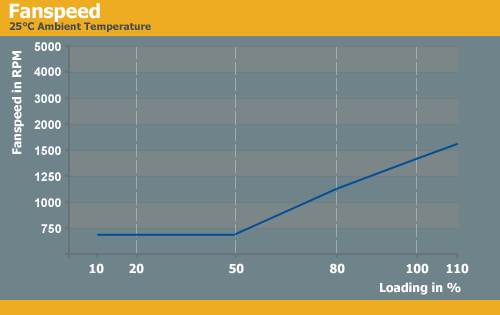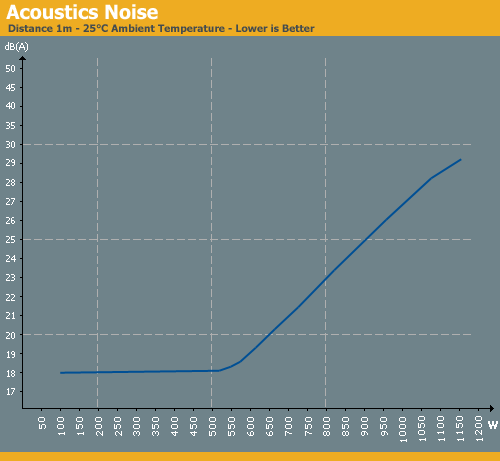Enermax Revolution 85+ High Efficiency PSU
by Christoph Katzer on November 6, 2008 4:15 AM EST- Posted in
- Cases/Cooling/PSUs
Temperatures, Fan Speed, and Acoustics

The high efficiency means that this power supply needs to dissipate less heat, which is icing on the cake. The temperatures on both heatsinks are so low that you could practically run this PSU fanless. Once we hit 100% load, temperatures start to increase, but we don't expect very many users to come anywhere near that point. What's interesting is that fan speed begins to ramp up faster than temperatures, and in fact the temperature graphs drop between the 80% and 100% load marks. Still, better safe than sorry. As for the exhaust temperature, it's very close to the heatsink temperatures, so the heatsinks and fan are doing a good job of getting heat out of the power supply.

As we saw in the temperature graph, fan speed begins to ramp up at around a 500W/50% load. It spins at 750 RPM up until the 50% mark, at which point fan speed ramps up linearly until the maximum 1500-1600 RPM at 100% load.

Noise levels for the first half of the graph are extremely low, but unfortunately noise increases rapidly with fan speed beyond that point. This is a real pity, since the heatsinks aren't even that hot and it certainly would be possible to run the fan at a lower speed. The starting point of 18dB(A) is not something you will even notice, and we couldn't hear any ticking noises either (something we have seen in non-PWM controlled fans). However, the final output of 29dB(A) definitely doesn't qualify as being silent. The good news is that you can use this power supply up to a load of around 800W and still have an acceptable amount of noise, which is sufficient for even triple SLI systems -- and those will create plenty of noise just from the graphics cards. Truthfully, for a unit delivering over 1100W of power, 29dB(A) is not at all something we would call a poor result.










49 Comments
View All Comments
xaris106 - Thursday, November 6, 2008 - link
sorry if my english are not good. its not my first language.Aside from that i know what a kilowatt and losses are. I`m not saying they did something wrong. I just wanted some more info on the matter for the pros and cons...
araczynski - Thursday, November 6, 2008 - link
i suppose they're putting all that tech into the very high end market for the same reason as all other techs do; its easy to charge an extra premium (above the normal premium) from those buyers.sooner or later the technology will trickle down into the 'normal' market, where there is more serious volume.
but that's alright, the very high end market just ends up paying our share of the R&D costs that get passed on to them, instead of us.
'bleeding edge' or something they call it? 'bleeding' green :)
JarredWalton - Thursday, November 6, 2008 - link
The real problem is trying to get all of the necessary parts into a "reasonable" PSU, like something in the 600W or lower range for example. I'd guess they probably put around $100-$150 worth of parts and components into this design, making it fit for the high-end but not much else. If you want to sell 500W PSUs, pricing needs to be below $100 for sure to be competitive, and it's just not all that practical to get there with top-end components (IMO).Keep in mind that most people run PSUs at around 50% load if they want peak efficiency, so this PSU is really ideal for anyone running a ~500W system. GTX 280 SLI with an overclocked quad-core would be just about right I think... if you have enough extra HDDs. That it *can* run anything from 200W to 950W with 85% efficiency (and even beyond if you use 230VAC and want to overload the PSU) is extremely impressive.
Phew - Thursday, November 6, 2008 - link
"When I first saw the filtering stage, I asked the representatives at Enermax if CWT is the ODM"I consider myself pretty savvy about computer hardware, and I have two engineering degrees (mechanical), but that sentence was meaningless to me.
If you are going to use multiple obscure acronyms in one sentence, please at least include links to what they stand for and some description. It shouldn't take an electrical engineering degree to understand an article on a 'mainstream' computer hardware website.
yeti514 - Friday, November 7, 2008 - link
I don't know about this PSU, but the PSUs in the link below sure look like some Thermaltake units that were made by CWT to me.http://www.enermaxusa.com/catalog/product_info.php...">http://www.enermaxusa.com/catalog/produ...sCsid=e8...
nevbie - Thursday, November 6, 2008 - link
Channel Well Technologies (company..)Original Design Manufacturer (..which was the manufacturer)
Or along those lines.
Note that this is a mainstream enthusiast computer hardware website. =P
Phew - Thursday, November 6, 2008 - link
When your computer hardware website has a power supply review listed right next to a digital camera review and a Guitar Hero article, that is about as 'mainstream' as it gets.Thanks for the acronym explanation
petersterncan - Thursday, November 6, 2008 - link
I will never buy this line of PSUs unless they came out with a 300-350W model.The systems I build use on-board graphics, on-board audio, one HD, one energy efficient CPU and one optical drive. Fully configured, the systems I build for myself only use around 110 watts. Anything over 350W results in wasted electricity.
Look at the minimum power consumption and efficiency at low power draws! That's the most relevant info for me when selecting a PSU.
Calin - Thursday, November 6, 2008 - link
You can have in USA electrical power on 240V. And the power source will go just as well at 220/230V of Europe as with 240Vstrikeback03 - Thursday, November 6, 2008 - link
Problem would probably be getting the proper cable for the US. Might have to make it yourself.